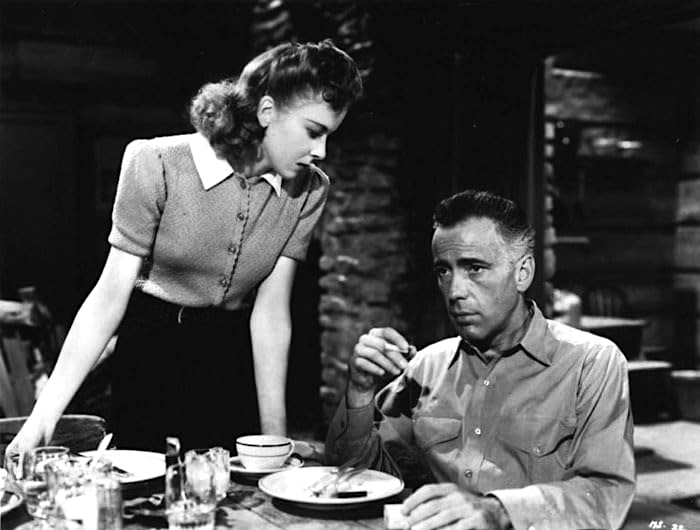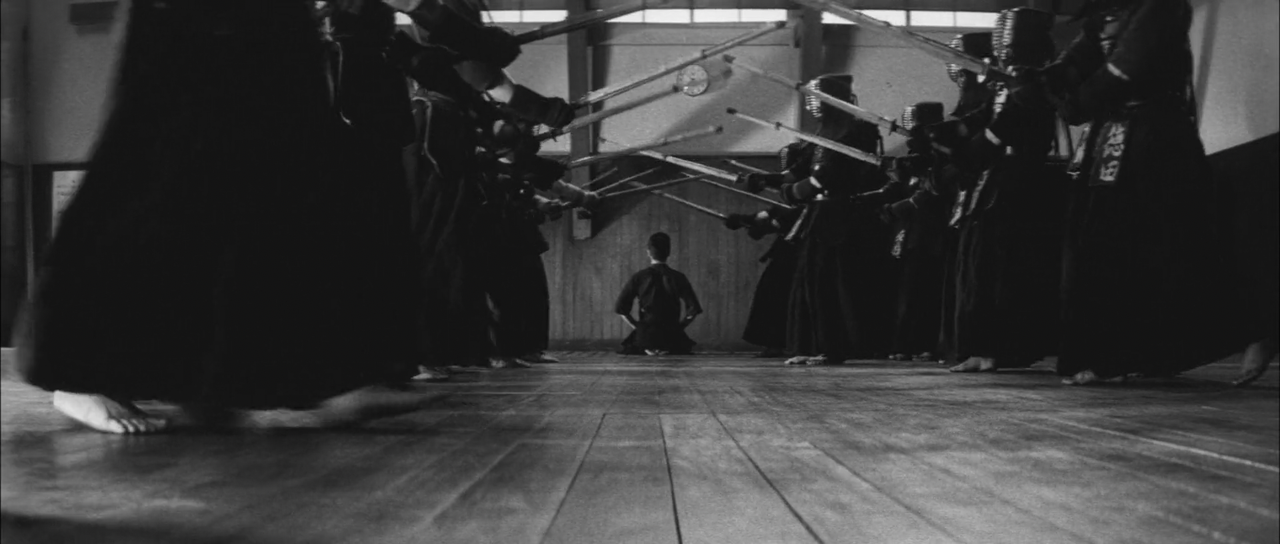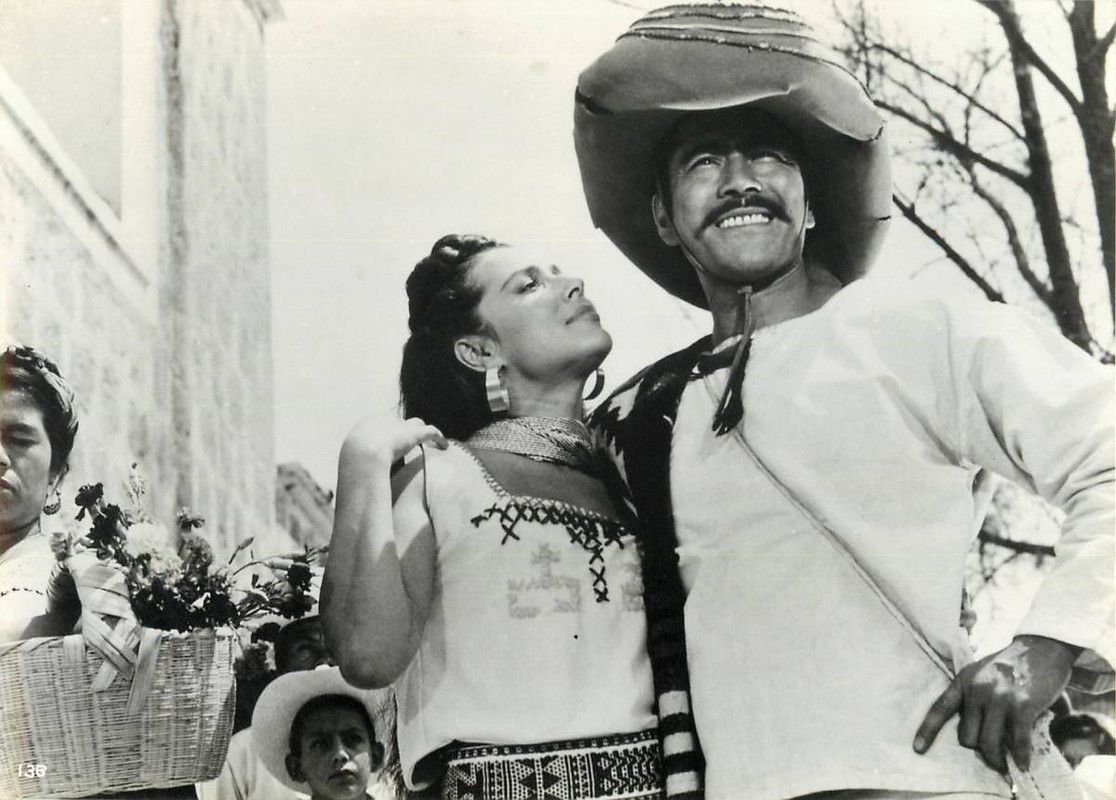Иконостасът [Ikonostasat / The Icon Stand] (Christo Christov + Todor Dinov, 1969)
Feb
5
apples

A closeup of woman's hand moving an apple. The black-and-white photography is deliberately out of focus. DP: Atanas Tasev.
BookAdaptation
“Excuse me, Mrs. Crane. This coffee made me think how good whiskey would taste.”Day of the Outlaw (André De Toth, 1959)
Feb
2
coffee

Blaise Starrett (Ryan) and Mrs Crane (Louise) at a table. There are coffee cups and the talk is tense. DP: Russell Harlan.
– Dan, Starret's foreman
Touha zvaná Anada [Desire Called Anad / Adrift] (Elmar Klos + Ján Kadár, 1968/1971)
Jan
21
salt

Semi-off screen, an older man with a moustache at a dinner table – many plates, glasses, and foods – reaches for a bowl of salt. DP: Vladimír Novotný.
“Roy, this is the land of milk and honey for the health racket. Every woman in California thinks she's either too fat or too thin or too something.”High Sierra (Raoul Walsh, 1940)
Jan
19

Roy Earle (Bogart) pensively smoking an after-meal cigarette while Marie Garson (Lupino) looks on. DP: Tony Gaudio.
– 'Doc' Banton
“Time to empty our slop pails and run a little water over our faces, then back to our cells for the entire day.”Un condamné à mort s'est échappé ou Le vent souffle où il veut [A Man Escaped] (Robert Bresson, 1956)
Dec
29
slop

A man's hand holds a spoon at a perpendicular angle. DP: Léonce-Henri Burel.
– Fontaine
– So what is your goal in life then? – Satisfaction of the present. The sword, and nothing else.剣 (小説) [Ken / The Sword] (Kenji Misumi, 1964)
Dec
29
Tick Tock Day

One of the kendōka kneeled on the floor in gruelling punishment faces a clock on the wall, while the other students continue their training. DP: Chikashi Makiura.
A clock face on Tick Tock Day (USA)
After World War II, the Japanese martial arts of #kendo was banished by the occupying forces in an attempt to “remove and exclude militaristic and ultra-nationalistic persons from life”. With that in mind, it makes complete sense that nationalist author and former kendo practitioner Yukio Mishima wrote a short story – Sword, originally published in literary magazine Shincho in 1963 – about the art.
Both the story and Kenji Misumi's 1964 film adaptation follow arrogant kendo student Jiro, played by sublime kabuki actor Raizō Ichikawa who also appears in an earlier Mishima adaptation, 炎上 [Enjō / The Temple of the Golden Pavilion / Conflagration] (1958).
飼育 [Shiiku / The Catch] (Nagisa Ōshima, 1961)
Dec
26
offerings

An altar with two rotund, smiling stone statues – possibly Jizō, a bowl of rice with chopsticks stuck into it, and a Japanese soldier's photograph. The position of the chopsticks tells us that the soldier has died. DP: Yoshitsugu Tonegawa.
“Only a child can kill the monster.”Si muero antes de despertar [If I Should Die Before I Wake] (Carlos Hugo Christensen, 1952)
Dec
19
National Hard Candy Day

Lucio (Néstor Zavarce) and his new friend sharing one of her fancy 10¢ lollipops. DP: Pablo Tabernero.
Eating hard candy on National Hard Candy Day (USA)
Lucio is the class clown, a ne'er-do-well relying on his police-dad's rank and classmates' homework. One of these classmates, a smart little girl, promises him fancy lollipops in exchange for protection. And she has a secret for him too, about the origin of the candy, and the nice man giving her those and other nice things. Under oath, she tells Lucio everything and then promptly disappears. With his friend gone, killed as he later finds out, and an oath weighing on his heart, what can Lucio do when another girl goes missing?
– narrator
Cornell Woolrich's haunting tales of childhood lost leaped from Ireland to Argentina. With some similarities with Fritz Lang's M (1931), this fairy-tale feels more oppressive; due to the helplessness of a boy's power in an adult world and his understanding of grown-up responsibilities. A restored version in wider circulation is long overdue.
Ánimas Trujano (El hombre importante) [The Important Man] (Ismael Rodríguez, 1961)
Dec
16
Underdog Day

Now very important Ánimas Trujano [Toshirō Mifune] holding his Juana (Columba Domínguez). DP: Gabriel Figueroa.
An underdog for National Underdog Day (USA)
Underdog Ánimas Trujano is dead set on becoming his town's next mayordomio, the wealthy, respected man in charge of funding one of Oaxaca's major religious festivals. He does find a way, a terrible one, and does get the respect and riches he wishes for. But even with all the money and praise in the world, Ánimas' continuous down his well-trodden path of gambling away the riches bestowed, and cheating on his long-suffering wife.
It took me a moment to get comfortable with the casting of Japanese movie legend Toshirō Mifune as the titular important man (also see Noé Murayama in Rodríguez's Los hermanos Del Hierro from 1961, but from that moment on, Ánimas Trujano feels as universal as any great cinematic experience should be.
“Have you seen Mr Tavernier tonight?”Ascenseur pour l'échafaud [Elevator to the Gallows] (Louis Malle, 1958)
Dec
13
croissants

Mr Tavernier (Maurice Ronet) taking a bite out of a croissant while dialling a number in a lively French café. A blonde behind him shows an interest. DP: Henri Decaë.